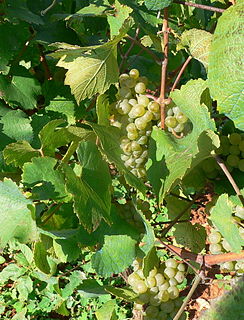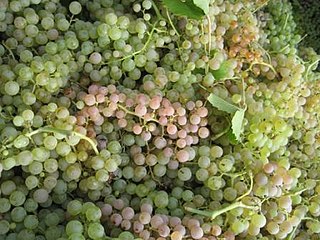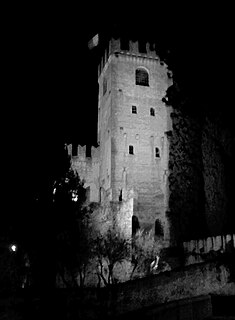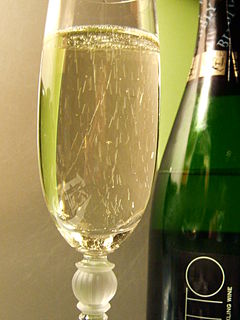
Malvasia is a group of wine grape varieties grown historically in the Mediterranean region, Balearic Islands, Canary Islands and the island of Madeira, but now grown in many of the winemaking regions of the world. In the past, the names Malvasia, Malvazia, and Malmsey have been used interchangeably for Malvasia-based wines; however, in modern oenology, "Malmsey" is now used almost exclusively for a sweet variety of Madeira wine made from the Malvasia grape. Grape varieties in this family include Malvasia bianca, Malvasia di Schierano, Malvasia negra, Malvasia nera, Malvasia nera di Brindisi, Malvasia di Candia aromatica, Malvasia odorosissima, and a number of other varieties.

Garganega is a variety of white Italian wine grape widely grown in the Veneto region of North East Italy, particularly in the provinces of Verona and Vicenza. It is Italy's 6th most widely planted white grape. It forms the basis of Venetian white wine Soave and is also a major portion of the blend used to make Gambellara.

Conegliano is a town and comune of the Veneto region, Italy, in the province of Treviso, about 30 kilometres (19 mi) north by rail from the town of Treviso. The population of the city is of 35,023 people. The remains of a 10th-century castle are situated on a hill that dominates the town. Formerly belonging to the Bishop of Vittorio Veneto, what remains is a bell tower, which now houses a small museum, and outer walls.

Vermentino is a light-skinned wine grape variety, primarily found in Italian wine. It is widely planted in both in Sardinia and Liguria, to some extent in Corsica, in Piedmont under the name Favorita, and in increasing amounts in Languedoc-Roussillon. The leaves are dark green and pentagonal. The grapes are amber-yellow and hang in pyramidal bunches. The vines are often grown on slopes facing the sea where they can benefit from the additional reflected light. The Vitis International Variety Catalogue now gives Italy as its origin.

Breganze is a town in the province of Vicenza, Veneto, Italy. It is northeast of Via Romea. During World War II, the Germans were on one side of the river and the Allies were on the other, and a firefight occurred across the river.
Raboso is a red wine grape grown primarily in the eastern part of Veneto. It is also called Raboso Piave, from the name of a river near where it is grown. It produces deep-colored wine, with notably high levels of tannin and medium alcohol content and high acid. The name raboxo in the native Venetian language means "angry", because angry is the sensation in the mouth when this wine is drunk young. Raboso was in the past the most cultivated grape variety of eastern Veneto; Venetian navigators called it vin de viajo, "wine of travel", because it was the most resistant to aging and transport. Its popularity decreased in the 20th century, and today the vineyards of Raboxo are just 1–2% of the total amount of vineyards in Veneto.

Marzemino is a red Italian wine grape variety that is primarily grown around Isera, south of Trentino. The wine is most noted for its mention in the opera Don Giovanni of Wolfgang Amadeus Mozart. The vine ripens late and is susceptible to many grape diseases including oidium. Wine produced from the grape has a characteristic dark tint and light plummy taste.
Venetian wine is produced in Veneto, a highly productive wine region in north-eastern Italy.
Cortese is a white Italian wine grape variety predominantly grown in the southeastern regions of Piedmont in the provinces of Alessandria and Asti. It is the primary grape of the Denominazione di origine controllata (DOC) wines of Cortese dell'Alto Monferrato and Colli Tortonesi as well as the Denominazione di Origine Controllata e Garantita (DOCG) wine of Cortese di Gavi. Significant plantings of Cortese can also be found in the Lombardy region of Oltrepò Pavese and in the DOC white blends of the Veneto wine region of Bianco di Custoza. Cortese has a long history in Italian viticulture with written documentation naming the grape among the plantings in a Piedmontese vineyard as early as 1659. The grape's moderate acidity and light flavors has made it a favorite for the restaurants in nearby Genoa as a wine pairing with the local seafood caught off the Ligurian coast.

Vespaiola is a white Italian wine grape variety planted primarily in the Veneto region of northeastern Italy, where it is often dried to produce passito style dessert wines. Along with Friulano, Vespaiola is an important component in the Denominazione di origine controllata (DOC) white wine of Breganze produced in the province of Vicenza.

Incrocio Manzoni or Manzoni grapes is a family of grape varieties named after Professor Luigi Manzoni (1888-1968) of Italy's oldest school of oenology located in Conegliano, in the Veneto region. Manzoni created the new grape varieties by selecting, crossing and grafting vines from various vineyards during the 1920s and 1930s. The family includes both white and red grape varieties. Although most Manzonis are grown in northeastern Italy, they are mainly grown in the Piave area of Province of Treviso and are only now starting to be sold commercially in Europe and the United States.

Coda di Volpe is a white Italian wine grape variety that has been historically grown in the Campania region around the town of Naples. It is often confused with another white Italian wine grape, Emilia, that share many of the same synonyms as Coda di Volpe.

Verdiso is a white Italian wine grape variety grown primarily in province of Treviso in the Veneto wine region of northeast Italy. It is a permitted variety in the sparkling wine Denominazione di origine controllata DOC of Prosecco located north of the city of Treviso along the Piave river.

Nosiola is a white Italian wine grape variety that is grown in the Trentino region north of Lake Garda in the Valle dei Laghi. Here it is used in varietal Denominazione di origine controllata (DOC) wines and as a blending component in wines such as Sorni Bianco from Trento. It is also used to produce a dessert wine in the Vin Santo style from grapes that have been allowed to dry out prior to fermentation.
Albaranzeuli bianco is a white Italian wine grape variety that is grown primarily in Sardinia. Ampelographers use to believe that the grape was originally Spanish in origin and was introduced to the island when it was ruled by the Crown of Aragon. Recent DNA profiling has suggested that the grape may have originated on the island as a crossing between the red Sardinian wine grape Girò and the Spanish table grape Molinera, known locally as Pansa Rosa di Málaga and distinct from the Veneto wine grape Molinara that is used in Amarone. A pink skinned grape known as Albaranzeuli nero is also found in Sardinia but its exact relationship to Albaranzeuli bianco is not yet clear.
Marzemina bianca is a white Italian wine grape variety that is grown in the Veneto region of northeastern Italy. Ampelographers believe that the grape is a natural crossing of the Trentino wine grape Marzemino and the Soave wine grape Garganega. This parent-offspring relationship between Marzemina bianca and Marzemino makes the variety distinct from grapes like Pinot blanc and Grenache blanc which are other color mutations of Pinot noir and Grenache, respectively. DNA analysis has confirmed that the Veneto grape Raboso Veronese is the offspring of Marzemina bianca and Raboso Piave.
Barbera bianca is a white Italian wine grape variety that is grown in the Piedmont wine region of northwest Italy. Despite being named Barbera bianca, the grape is not a color mutation of the red Piedmontese wine grape Barbera that is the third most widely planted grape variety in Italy. In fact, DNA analysis conducted in the early 21st century shows no genetic relationship at all between the two grape varieties.
Minella bianca is a white Italian wine grape variety that is indigenous to the island of Sicily where it is grown in the foothills of Mount Etna. The name Minella is derived from the Sicilian word minna to which the berries have some resemblance due to their elongated shape. Minella bianca is very rarely seen as a varietal and is most often used in field blends with Carricante and Catarratto bianco.
Bianchetta Trevigiana is a white Italian wine grape variety that is grown in the Trentino-Alto Adige/Südtirol and Veneto wine regions of northeast Italy. Here the grape is rarely used a varietal but, instead, is a permitted blending grape adding acidity to the wines of several Denominazione di Origine Controllata (DOC) zones including the sparkling wine Prosecco and has also been used for vermouth production. The name Trevigiana is derived from the province of Treviso where the grape is believed to have originated from.
Bigolona is a white Italian wine grape variety from the Valpolicella region of northeast Italy where it has been growing since at least the early 19th century. The wine has traditionally been used in the production of late harvest and botrytized dessert wines with the grape's synonym Smarzirola being derived from the Italian marcire meaning "to rot".











